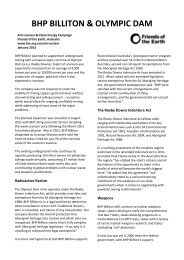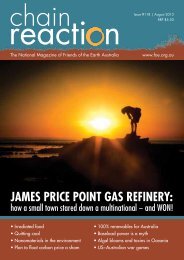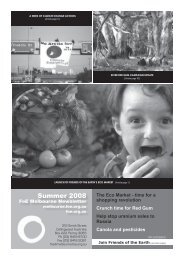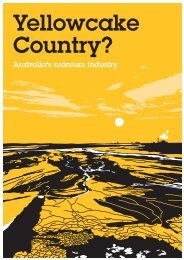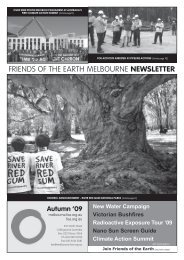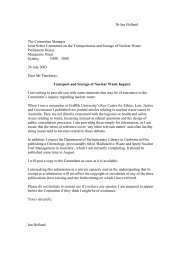Thirty Years of Creative Resistance - Friends of the Earth Australia
Thirty Years of Creative Resistance - Friends of the Earth Australia
Thirty Years of Creative Resistance - Friends of the Earth Australia
You also want an ePaper? Increase the reach of your titles
YUMPU automatically turns print PDFs into web optimized ePapers that Google loves.
Easter 1986. The ‘Broad Left’ conference<br />
addressed <strong>the</strong> emergence <strong>of</strong> a ‘more<br />
extreme and confident right wing in<br />
<strong>Australia</strong> and how <strong>the</strong> left could effectively<br />
meet this challenge’. The ‘Getting<br />
Toge<strong>the</strong>r’ conference attempted to show<br />
“<strong>the</strong> common ground shared between <strong>the</strong><br />
various faces <strong>of</strong> <strong>the</strong> alternative movements<br />
in <strong>Australia</strong>, and to find ways <strong>of</strong> using<br />
our common ideals to streng<strong>the</strong>n mutual<br />
support”.<br />
External influences also affected <strong>the</strong><br />
organisation and broader environment<br />
movement in <strong>the</strong>se years. On July 10,<br />
1985, two mines exploded on <strong>the</strong> hull <strong>of</strong><br />
<strong>the</strong> Greenpeace boat Rainbow Warrior<br />
ber<strong>the</strong>d in Auckland harbour killing<br />
Greenpeace photographer Fernando<br />
Pereira. Green groups had to become<br />
more careful about infiltration and ‘dirty<br />
tricks’ campaigns. The threat <strong>of</strong> nuclear<br />
war continued and, as more activists<br />
became influenced by punk culture<br />
and disillusioned at <strong>the</strong> ability <strong>of</strong> mass<br />
mobilisations to have impact on big<br />
picture decisions, more spontaneous and<br />
disruptive actions such as ‘Stop <strong>the</strong> City’<br />
protests started to occur.<br />
In Melbourne, Young People Against<br />
Global Violence organised <strong>the</strong> first ‘Stop<br />
<strong>the</strong> City’, targeting <strong>the</strong> stock exchange,<br />
WMC and o<strong>the</strong>r sites to ‘expose <strong>the</strong> role<br />
<strong>of</strong> financial institutions in <strong>the</strong>ir … pr<strong>of</strong>itable<br />
business <strong>of</strong> militarism and oppression.’<br />
These actions were consciously anarchist<br />
in style and structure. Cold War conflicts<br />
and <strong>the</strong> threat <strong>of</strong> nuclear annihilation<br />
continued, yet <strong>the</strong>se issues were seen by<br />
many in <strong>the</strong> broader community as ei<strong>the</strong>r<br />
a remote threat or one about which <strong>the</strong>y<br />
could do nothing.<br />
In terms <strong>of</strong> global politics, <strong>the</strong> <strong>Australia</strong>n<br />
Journal <strong>of</strong> Mining (AJM) suggested that<br />
in <strong>the</strong> struggle between <strong>the</strong> USA and <strong>the</strong><br />
USSR, FoE was effectively on <strong>the</strong> side <strong>of</strong><br />
<strong>the</strong> Soviet Union: “it is part <strong>of</strong> a network <strong>of</strong><br />
peace organisations which regard <strong>the</strong> USA<br />
and <strong>the</strong> multinationals – and not <strong>the</strong> USSR<br />
- as <strong>the</strong> prime threat to world peace”. The<br />
article failed to explain why FoE responded<br />
so strongly to <strong>the</strong> Chernobyl disaster<br />
...................................................................................................................................................................................................<br />
In 1998, FoE <strong>Australia</strong> hosted <strong>the</strong> international<br />
network for <strong>the</strong> fime.<br />
beyond claiming that previously FoE<br />
had viewed <strong>the</strong> Soviet nuclear program<br />
as being ‘socialist’ and <strong>the</strong>refore ‘good’.<br />
The AJM’s conspiracy <strong>the</strong>ory approach<br />
to <strong>the</strong> role <strong>of</strong> environmental groups and<br />
particularly to FoE continued when <strong>the</strong><br />
Journal also claimed that some articles in<br />
Chain Reaction contained ‘many Soviet<br />
disinformation <strong>the</strong>mes’.<br />
As <strong>the</strong> decade wore on, waste<br />
minimisation in general and recycling<br />
in particular grew as issues. The FoEM<br />
recycling campaign, through <strong>the</strong> efforts<br />
<strong>of</strong> Fran McDonald and Murray Keeble<br />
carried out excellent work in this area. The<br />
dominant campaign <strong>of</strong> <strong>the</strong> time focussed<br />
on demands to legislate for deposits to be<br />
paid on drink containers. South <strong>Australia</strong><br />
FoE 30 <strong>Years</strong> 38



